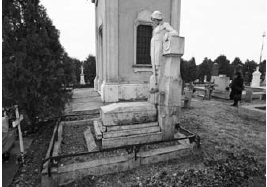Ferenc Gal (Gaál Ferenc) was born on March 27, 1860, in the excavation on the territory of today’s Slovakia. He lost his parents early, and the older brother Pied took care of him. Elementary school and lower secondary school attend classes in Nyitra, and continue in Budapest. Parallel to the National Music Institute (Nemzeti Zenede). He is a great student, speaks Hungarian, German, Slovak, Czech, and also Latin and French.
He attended the Academy of Music between 1878 and 1882, and the studies end with great success.
Gal was appointed director of the Music School in Subotica on October 1, 1882, and he was also the conductor and leader of the Church of St. Theresa of Avila. He began to work with great ambitions: in 1883, he managed to sing as a special subject to the program of gymnasium, municipal women’s civic school and several elementary schools in the city. He taught himself the new subject. He planned to extend the length of his schooling from three to six years and to introduce a piano chair. The city’s first appeal was refused, while the piano director agreed, but its opening took place only six years later, as the city had no instrument until then.
Although Gal was the only academically educated musician in the city, he failed to impose himself on Subotica’s elite society. He did not find his place in a music school, and he did not manage to find a common language with his colleagues.
One hundred twenty compositions were printed in the then Hungary and abroad. Especially popular are his Hungarian rhapsody, artistic and folk songs, church compositions of mixed choirs and various treatments. He received the first prize at the National Singing Society Competition, which was announced on the occasion of the celebration of the thousandth anniversary of the Hungarian state.
He always tried to promote musical culture, giving concerts in Subotica, Palic, Paris, Vienna, Zurich, Rome, London, Berlin and Budapest. He is most likely performing romantic composers List, Chopin and Mendelssohn, but not rarely his compositions.
It does not travel only in Western Europe, but also in the Balkans. He holds concerts in Serbia and Bulgaria in 1887. On this trip she meets with the actress Zork Teodosijevic who meets him with Stevan Mokranjac. The two composers make a close friendship on that occasion. And in Subotica she cooperates with the Serbian Singing Society, participates in events (Texts), which was organized by the Charity Cooperative of Srpkinja. He wrote accompanying music for the play “Kraljević Marko” by Velja Miljković, tattered with motifs from Serbian folk songs. The triumph of this piece was in Subotica, April 29, 1894. Subotica’s cultural life enriched with calls from world-class artists, among them in April 1889, Maria Wilt, (Maria Wilt) hosts the Vienna Opera Pride.
His name was linked to the founding of the craftsman’s choir in 1898, whose first conductor was. He organized his creative evening on April 13, 1903, on the occasion of the twentieth anniversary of creative work. It turned out that it was already late. At that time, he had already given up so much alcohol that his liver had been caught by cirrhosis. In November 1906, he received a jaundice which the weakened organism failed to overcome. He died on December 11, 1906, at the age of forty. They buried him at the suburban Baja cemetery, two days later. Already during the funeral, the famous Subotic writer Izidor Milko suggested raising a monumental tombstone.
According to Marta Kenyeres Márta: “Ferenc Gal was not the original creator, he could not add anything new in the music culture of his time. He wrote essentially appealing, light pieces, which were intended for a wider auditorium. ”
The tombstone of Ferenc Gala is among the symbolic tombstones, and it was made by sculptor Albert Keller. The name of the author is on the tombstone: Keller Albert szobrász Szabadka 1906.
A complete monument was made in the style of secession. Above the hummus, a stand extends in height and forms a support for a female figure in its natural size. The stylization of the form, characteristic of secession, was masterfully carried out in stone. A figure of a sad girl standing upright or bent head. She rests on the plate, and with her hands adhere to the laurel wreaths with three strips. A veil that stylically connects hair and scarf is made around her head. The girl’s body covering the body is covered with a wide waist under the breast, with a shallow relief made with floral decoration and a strip that runs downwards.
On the floor, there is an inscription on the facade. The Humka is surrounded by a stone, identical as a tombstone and cast iron castle in the same style.
TOMB OF GAÁL FERENC


0 comments on “TOMB OF GAÁL FERENC”